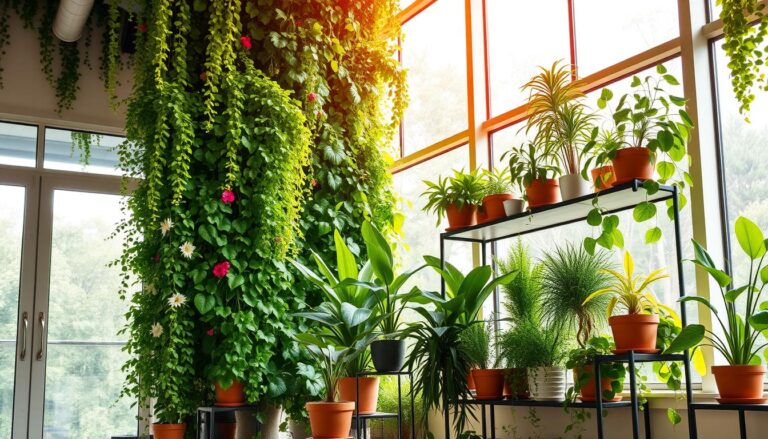Urban gardening has become an essential part of sustainable living, and sustainable water management is at its core.
Nourishing your garden naturally involves utilizing rainwater, a practice that dates back centuries but has evolved with modern innovations.
By adopting rainwater harvesting for urban gardens, homeowners can significantly reduce their water bills and contribute to a more eco-friendly environment.
This ancient practice, revamped with modern techniques, not only maximizes water collection efficiency but also minimizes environmental impact.
Key Takeaways
- Rainwater harvesting is a sustainable practice for urban gardening.
- It contributes to sustainable water management.
- Modern innovations have improved rainwater collection efficiency.
- Adopting rainwater harvesting can reduce water bills.
- It’s an eco-friendly approach to gardening.
The Value of Water Conservation in Urban Environments
As urbanization continues to rise, the importance of water conservation in urban environments cannot be overstated. Urban gardening, a growing trend, relies heavily on water resources, making conservation methods crucial for sustainability.
The Urban Water Crisis
Urban areas often face water management challenges due to high population densities and infrastructure demands. The urban water crisis is exacerbated by traditional gardening practices that waste significant amounts of water.
Environmental Impact of Traditional Gardening
Traditional gardening methods can lead to environmental degradation through excessive water use and chemical runoff. Adopting eco-friendly gardening practices can mitigate these impacts.
Creating Sustainable Urban Spaces
By implementing water conservation methods, urban gardeners can create sustainable spaces that not only reduce water waste but also promote biodiversity. Effective water conservation strategies are key to achieving this goal.
| Water Conservation Method | Benefits | Impact |
|---|---|---|
| Rainwater Harvesting | Reduces water bills, Conserves potable water | High |
| Drip Irrigation | Reduces evaporation, Targets water delivery | Medium |
| Xeriscaping | Low water requirements, Drought tolerance | High |
Rainwater Harvesting for Urban Gardens: The Basics
Rainwater harvesting is a simple yet effective way to nourish your urban garden. By collecting and storing rainwater, you can reduce your reliance on municipal water supplies and create a more sustainable gardening practice.
Why Rainwater is Superior for Plants
Rainwater is superior for plants due to its natural pH and lack of chemicals found in tap water. This makes it ideal for urban gardens, where plants are often more sensitive to water quality. Using rainwater can lead to healthier plants and improved growth.
The Science Behind Rainwater Quality
The quality of rainwater is generally high because it’s collected from the atmosphere. However, it can be contaminated by particulates from the roof catchment. Regular maintenance of the collection system is crucial to ensure the water remains clean and safe for irrigation.
Calculating Your Potential Harvest
To calculate your potential harvest, consider the size of your roof catchment and the average annual rainfall in your area. A simple formula is: Roof Area (sq. ft.) x Rainfall (inches) x 0.623 = Gallons Collected. This will give you an estimate of how much rainwater you can harvest.
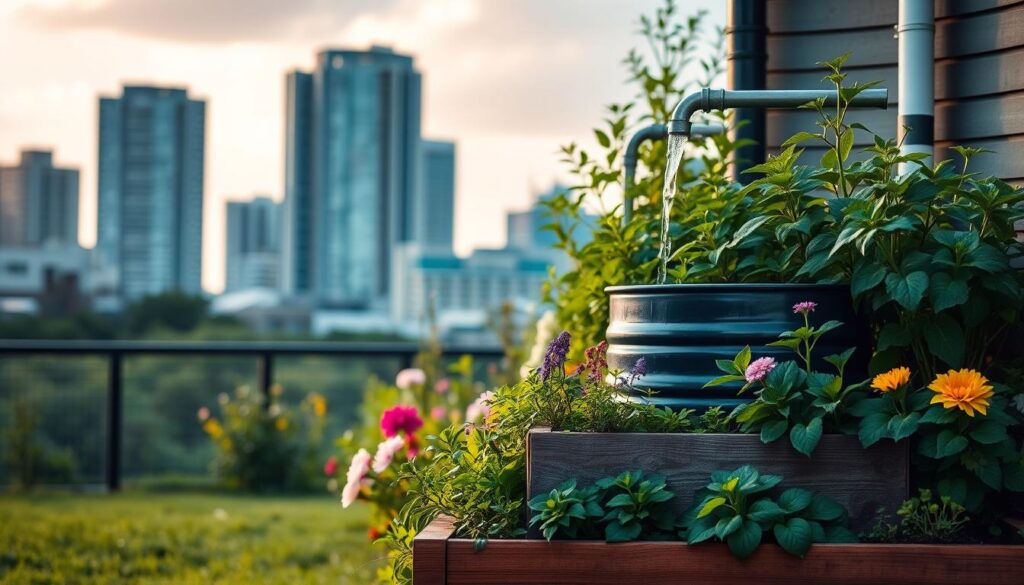
Types of Rainwater Collection Systems
Rainwater collection systems come in different forms, catering to diverse urban gardening needs. The choice of system depends on factors such as available space, budget, and the scale of your gardening project.
Simple Rain Barrels
Simple rain barrels are a popular and straightforward solution for urban gardeners. They are typically placed under downspouts to collect rainwater from rooftops. These barrels are available in various sizes, making them suitable for small to medium-sized gardens. Using rain barrels is an effective way to start harvesting rainwater with minimal investment.
Daisy-Chained Systems
Daisy-chained systems involve connecting multiple rain barrels together to increase storage capacity. This setup allows for more extensive rainwater collection and is ideal for larger urban gardens or for gardeners who want to maximize their harvesting potential. It’s a flexible and scalable solution that can be adapted to different garden sizes.
Underground Cisterns
Underground cisterns offer a more permanent and often larger capacity solution for rainwater harvesting. They are installed beneath the ground, making them ideal for gardens where space is limited or where a more discreet system is preferred. Underground cisterns can store significant amounts of rainwater, providing a reliable source for irrigation during dry periods.
Rain Gardens and Bioswales
Rain gardens and bioswales are innovative approaches to rainwater harvesting that also enhance garden aesthetics. They involve creating shallow depressions in the ground that collect and filter rainwater, allowing it to percolate into the soil. This not only conserves water but also helps to recharge groundwater. Rain gardens and bioswales are particularly effective in managing stormwater runoff and reducing erosion.
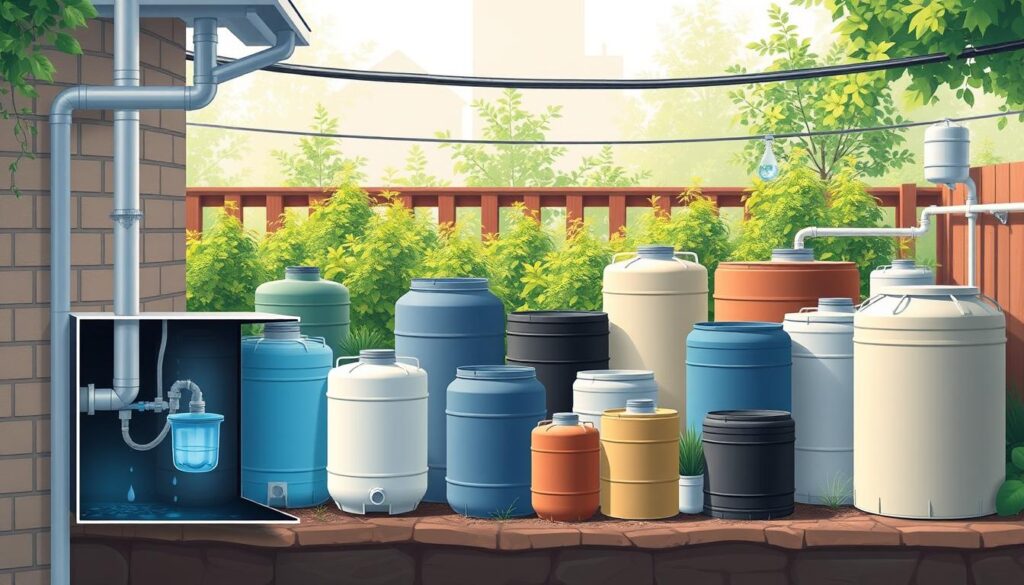
By understanding the different types of rainwater collection systems, urban gardeners can make informed decisions about which system best suits their needs, contributing to a more sustainable gardening practice.
Setting Up Your First Harvesting System
To start harvesting rainwater, you’ll need to assess your space and choose the appropriate collection system for your urban garden. This initial step is crucial for ensuring that your rainwater harvesting system is efficient and effective.
Assessing Your Space and Needs
Begin by evaluating your garden’s size, the amount of rainfall your area receives, and the type of plants you’re growing. This assessment will help you determine the ideal size of your rainwater collection system. Consider factors like roof catchment area, rainfall intensity, and the water requirements of your plants.
Essential Components and Materials
A basic rainwater harvesting system consists of a catchment area (usually the roof), gutters, downspouts, and a storage container. You’ll also need filters and a first flush diverter to ensure the quality of the collected water. Choose materials that are durable and suitable for outdoor use.

Step-by-Step Installation Guide
Installing your rainwater harvesting system involves several key steps.
Positioning Your Collection System
Place your storage container in a location that is easily accessible and close to your garden. Ensure it’s positioned to avoid any potential flooding or water damage.
Setting Up Gutters and Downspouts
Install gutters and downspouts to direct rainwater from your roof to the storage container. Make sure they’re securely attached and free of debris.
Installing Filters and First Flush Diverters
Use a filter to keep debris out of your storage container, and install a first flush diverter to divert the initial flow of water from the roof, taking any contaminants with it, and then allow clean water to flow into the tank.
Safety Considerations
When setting up your system, ensure that your storage container is covered to prevent mosquito breeding and child access. Regularly inspect your system for any signs of damage or wear.
By following these steps and considering your garden’s specific needs, you can create an effective rainwater harvesting system that supports your urban gardening efforts.
Efficient Irrigation Methods for Urban Gardens
Efficient irrigation is crucial for urban gardens, where water conservation is key to sustainability and plant health. By adopting the right irrigation methods, gardeners can ensure their plants receive the right amount of water without wasting this precious resource.
Gravity-Fed Drip Systems
Gravity-fed drip systems are an efficient and eco-friendly way to irrigate urban gardens. These systems use the natural force of gravity to deliver water directly to the roots of plants, reducing evaporation and runoff. By using harvested rainwater, gardeners can further enhance the sustainability of their irrigation practices.
Hand Watering Techniques
Hand watering is a simple yet effective method for irrigating urban gardens. When done correctly, it allows gardeners to target specific plants and avoid overwatering. Using a watering can or a hose with a spray nozzle, gardeners can control the amount of water delivered to each plant, making it an ideal method for small gardens or for plants with specific watering needs.
Automated Solutions
For a more convenient and consistent irrigation experience, automated solutions such as timers and smart irrigation controllers can be invaluable. These systems can be programmed to water plants at optimal times, reducing the risk of overwatering and ensuring that plants receive the right amount of moisture. When combined with harvested rainwater, automated irrigation systems can significantly enhance the sustainability of urban gardens.
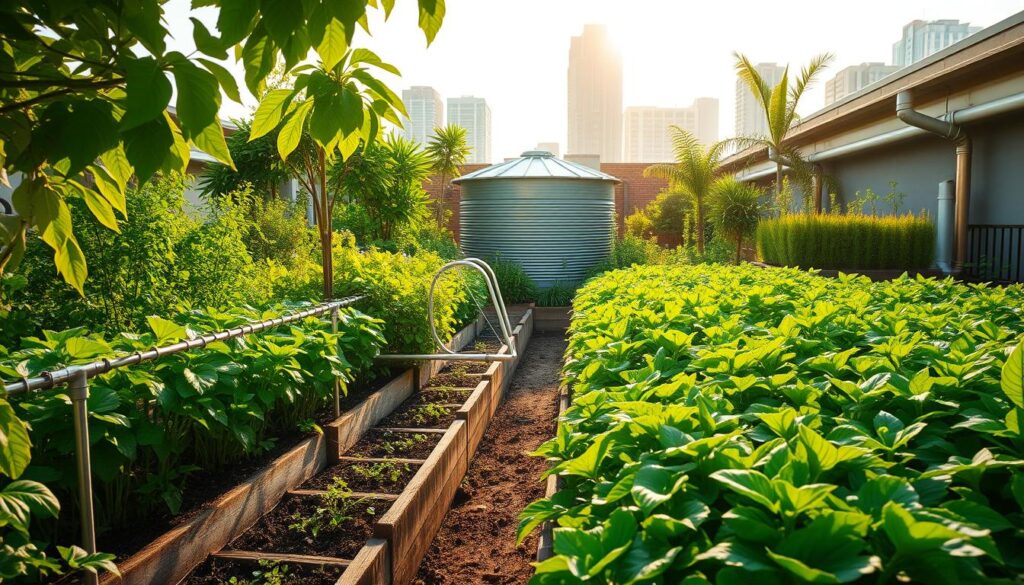
Maintaining Your Rainwater Harvesting System
To keep your rainwater harvesting system functioning optimally, regular maintenance is key. This involves several tasks that ensure the system’s longevity and effectiveness in supporting your urban gardening endeavors.
Seasonal Maintenance Checklist
A seasonal maintenance checklist is crucial for the upkeep of your rainwater collection systems. Before the rainy season begins, inspect your system for any debris or damage. Ensure that all connections are secure and that the overflow valve is functioning correctly.
- Check for debris and sediment buildup.
- Inspect the condition of the storage containers.
- Verify that the first flush device is working properly.
Preventing Mosquito Breeding
Preventing mosquito breeding is a critical aspect of maintaining your water harvesting solutions. Mosquitoes can lay eggs in standing water, posing health risks. To prevent this, ensure that your system is designed with mosquito-proof screens and that there are no gaps or openings in the storage containers.
| Prevention Method | Description |
|---|---|
| Mosquito-proof screens | Cover all inlets and outlets with fine mesh. |
| Tight-fitting lids | Ensure all containers have secure, tight-fitting lids. |
Cleaning and Sanitizing Storage Containers
Periodically cleaning and sanitizing your storage containers is vital to maintain water quality. Remove any sediment or debris, and then sanitize the containers with a non-toxic solution.
“Regular maintenance not only prolongs the life of your rainwater harvesting system but also ensures the health and vitality of your garden.”
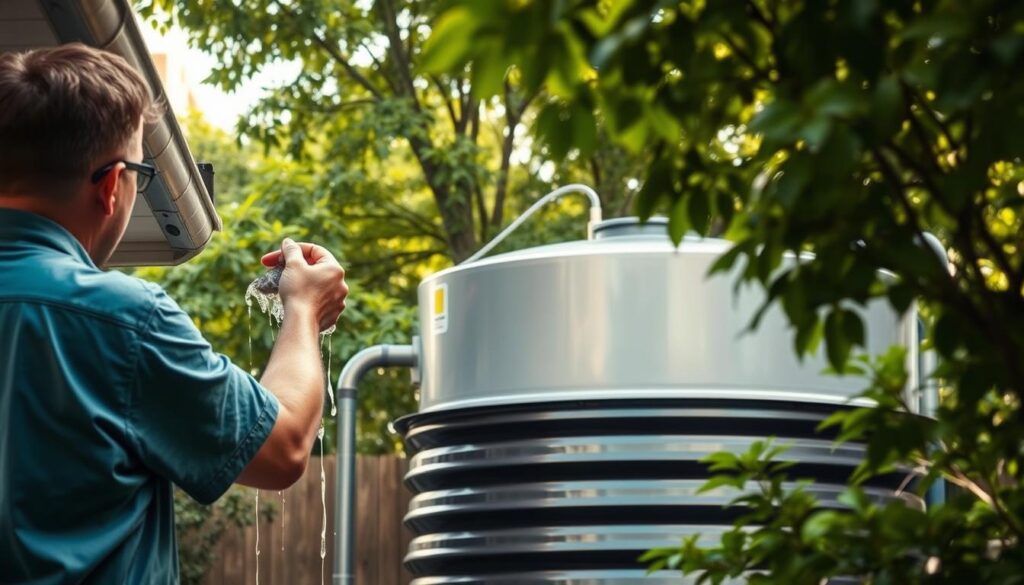
By following these maintenance tips, you can ensure that your rainwater harvesting system continues to support your urban gardening needs effectively.
Troubleshooting Common Rainwater Harvesting Issues
While rainwater harvesting offers numerous advantages, users often face problems that need immediate attention. Understanding how to troubleshoot these issues can significantly enhance the efficiency and longevity of your system.
Dealing with Overflow Problems
Overflow issues can lead to water wastage and potential damage to your garden or surrounding areas. To mitigate this, consider installing an overflow valve or redirecting the overflow to a rain garden or bioswale.
Regularly inspect your system to ensure that the overflow mechanism is functioning correctly.
Addressing Water Quality Concerns
Maintaining water quality is crucial for the health of your plants. Regularly clean your gutters and downspouts to prevent debris from entering your storage containers. Consider using a first flush device to divert initial runoff, which may contain contaminants.
Fixing Leaks and System Failures
Regular inspections can help identify leaks and potential system failures early on. Check all connections and fittings for signs of wear or damage, and replace them as necessary.
| Issue | Solution | Prevention |
|---|---|---|
| Overflow Problems | Install overflow valve or redirect to rain garden | Regular system inspection |
| Water Quality Concerns | Clean gutters and downspouts, use first flush device | Regular maintenance |
| Leaks and System Failures | Inspect and replace damaged connections | Regular inspections |

Cost Analysis and ROI of Rainwater Harvesting
The initial investment in a rainwater harvesting system can seem daunting, but the long-term benefits are substantial. As urban gardening continues to grow in popularity, understanding the financial implications of such a system is crucial.
Initial Setup Expenses
The cost of setting up a rainwater harvesting system varies widely, depending on the size of the system and the materials used. On average, a basic rainwater harvesting system can cost between $500 to $2,000. This includes the cost of tanks, gutters, downspouts, and other necessary components.
| Component | Cost |
|---|---|
| Rainwater Tank | $200-$1,000 |
| Gutters and Downspouts | $100-$500 |
| Pumps and Plumbing | $100-$500 |
Long-term Savings on Water Bills
By using rainwater for gardening and other non-potable purposes, homeowners can significantly reduce their water bills. According to the EPA, a typical household can save up to $200 annually on water bills by implementing rainwater harvesting.
“Rainwater harvesting is a simple and effective way to reduce your water bill and promote sustainable gardening practices.” –
DIY vs. Professional Installation
While DIY installation can save on labor costs, professional installation ensures that the system is designed and installed correctly, maximizing its efficiency and longevity. The choice between DIY and professional installation depends on the complexity of the system and the homeowner’s level of expertise.
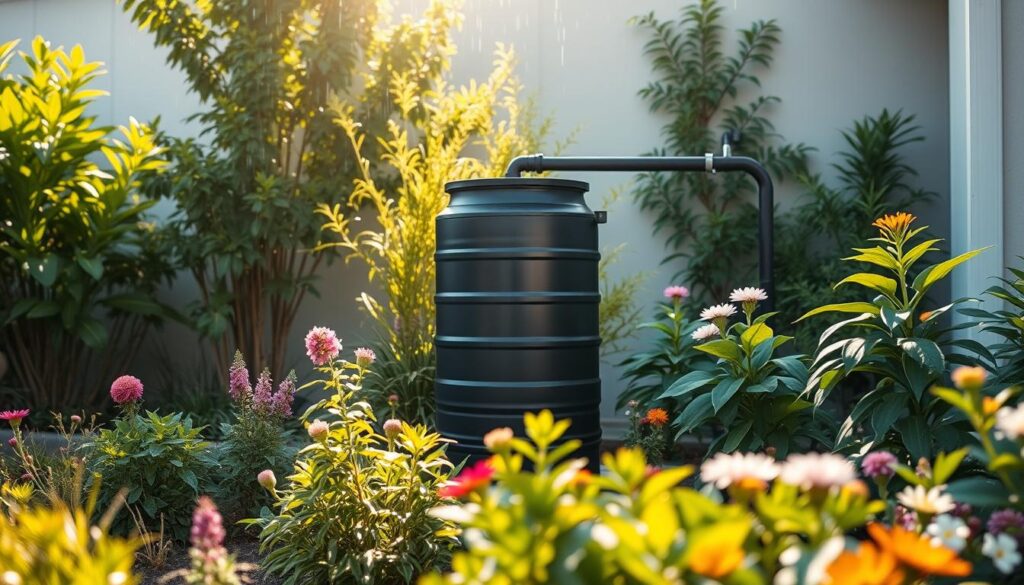
Legal Considerations for Urban Rainwater Collection
Before setting up a rainwater harvesting system, urban gardeners should familiarize themselves with the legal requirements and restrictions in their area. Understanding these regulations is crucial for a successful and compliant rainwater collection system.
State and Local Regulations in the US
Rainwater harvesting regulations vary significantly across different states and localities in the US. Some states encourage rainwater harvesting, while others have specific laws governing its use.
| State | Regulation | Allowance |
|---|---|---|
| California | Encouraged for landscaping | Yes |
| Colorado | Allowed with certain restrictions | Yes |
| New York | Regulated by local authorities | Varies |
It’s essential to check with local authorities for the most current information on rainwater harvesting regulations.
HOA Restrictions and Working Within Guidelines
For those living in areas governed by homeowners’ associations (HOAs), there may be additional rules to consider. HOAs can have specific guidelines regarding the installation of rainwater harvesting systems.
- Review your HOA’s bylaws and CC&Rs (Covenants, Conditions & Restrictions) to understand any limitations.
- Consider consulting with your HOA board to discuss your plans and ensure compliance.
- Be prepared to provide information on the benefits of rainwater harvesting to help address any concerns.
By understanding and adhering to these regulations, urban gardeners can successfully implement rainwater harvesting systems that are both effective and compliant with local laws and HOA rules.

Conclusion: Embracing Sustainable Water Practices
Embracing rainwater harvesting is a significant step towards sustainable water management and promoting eco-friendly gardening practices in urban environments. By adopting this practice, urban gardeners can reduce their reliance on municipal water supplies, decrease stormwater runoff, and create a more resilient gardening system.
As discussed, implementing a rainwater harvesting system can be straightforward, with various options available to suit different needs and spaces. From simple rain barrels to more complex underground cisterns, the benefits of rainwater harvesting can be realized by gardeners of all levels.
By integrating rainwater harvesting into urban gardening practices, individuals can contribute to a more environmentally friendly approach to gardening. This not only supports the health and vitality of their gardens but also plays a role in broader sustainable water management efforts.
As urban gardening continues to grow in popularity, embracing eco-friendly practices like rainwater harvesting can have a positive impact on the environment. By making this simple yet effective change, gardeners can help create a more sustainable future for urban gardening.

